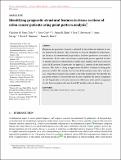Files in this item
Identifying prognostic structural features in tissue sections of colon cancer patients using point pattern analysis
Item metadata
| dc.contributor.author | Jones-Todd, Charlotte Moragh | |
| dc.contributor.author | Caie, Peter | |
| dc.contributor.author | Illian, Janine B. | |
| dc.contributor.author | Stevenson, Ben C. | |
| dc.contributor.author | Savage, Anne | |
| dc.contributor.author | Harrison, David J. | |
| dc.contributor.author | Brown, James L. | |
| dc.date.accessioned | 2019-11-28T00:37:01Z | |
| dc.date.available | 2019-11-28T00:37:01Z | |
| dc.date.issued | 2018-11-28 | |
| dc.identifier | 256417622 | |
| dc.identifier | cd9977d7-8278-4484-a12f-54c3d2711727 | |
| dc.identifier | 85057547234 | |
| dc.identifier | 000460319700009 | |
| dc.identifier.citation | Jones-Todd , C M , Caie , P , Illian , J B , Stevenson , B C , Savage , A , Harrison , D J & Brown , J L 2018 , ' Identifying prognostic structural features in tissue sections of colon cancer patients using point pattern analysis ' , Statistics in Medicine , vol. Early View . https://doi.org/10.1002/sim.8046 | en |
| dc.identifier.issn | 0277-6715 | |
| dc.identifier.other | ORCID: /0000-0002-0031-9850/work/60196556 | |
| dc.identifier.other | ORCID: /0000-0001-9041-9988/work/64034319 | |
| dc.identifier.uri | https://hdl.handle.net/10023/19014 | |
| dc.description.abstract | Diagnosis and prognosis of cancer is informed by the architecture inherent in cancer patient tissue sections. This architecture is typically identified by pathologists, yet advances in computational image analysis facilitate quantitative assessment of this structure. In this article we develop a spatial point process approach in order to describe patterns in cell distribution within tissue samples taken from colorectal cancer (CRC) patients. In particular, our approach is centered on the Palm intensity function. This leads to taking an approximate-likelihood technique in fitting point processes models. We consider two Neyman-Scott point processes and a void process, fitting these point process models to the CRC patient data. We find that the parameter estimates of these models may be used to quantify the spatial arrangementof cells. Importantly, we observe characteristic differences in the spatial arrangement of cells between patients who died from CRC and those alive at follow up. | |
| dc.format.extent | 3175948 | |
| dc.language.iso | eng | |
| dc.relation.ispartof | Statistics in Medicine | en |
| dc.subject | Colorectal cancer | en |
| dc.subject | Palm intensity function | en |
| dc.subject | Spatial point patterns | en |
| dc.subject | QA Mathematics | en |
| dc.subject | QA75 Electronic computers. Computer science | en |
| dc.subject | QH301 Biology | en |
| dc.subject | RC0254 Neoplasms. Tumors. Oncology (including Cancer) | en |
| dc.subject | NDAS | en |
| dc.subject | SDG 3 - Good Health and Well-being | en |
| dc.subject.lcc | QA | en |
| dc.subject.lcc | QA75 | en |
| dc.subject.lcc | QH301 | en |
| dc.subject.lcc | RC0254 | en |
| dc.title | Identifying prognostic structural features in tissue sections of colon cancer patients using point pattern analysis | en |
| dc.type | Journal article | en |
| dc.contributor.institution | University of St Andrews. Centre for Research into Ecological & Environmental Modelling | en |
| dc.contributor.institution | University of St Andrews. Cellular Medicine Division | en |
| dc.contributor.institution | University of St Andrews. School of Medicine | en |
| dc.contributor.institution | University of St Andrews. Statistics | en |
| dc.contributor.institution | University of St Andrews. Scottish Oceans Institute | en |
| dc.identifier.doi | https://doi.org/10.1002/sim.8046 | |
| dc.description.status | Peer reviewed | en |
| dc.date.embargoedUntil | 2019-11-28 |
This item appears in the following Collection(s)
Items in the St Andrews Research Repository are protected by copyright, with all rights reserved, unless otherwise indicated.

